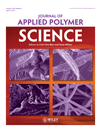Control of molecular weight distribution for polypropylene obtained by a commercial Ziegler–Natta catalyst: Effect of a cocatalyst and hydrogen
Abstract
The polymerization of propylene was carried out with an MgCl2-supported TiCl4 catalyst (with diisobutyl phthalate as an internal donor) in the absence and presence of hydrogen (H2) as a chain-transfer agent. Different structures of alkylaluminum were used as cocatalysts. The effects of the alkyl group size of the cocatalyst, H2 feed, and feed time on the propylene polymerization behaviors were investigated. The catalyst activity significantly decreased with increasing alkyl group size in the cocatalyst. The molecular weight and polydispersity index (PDI) increased with increasing alkyl group size. With the introduction of H2, the catalyst activity increased significantly, whereas the molecular weight and PDI of polypropylene (PP) decreased. Additionally, the effect of the polymerization time in the presence of H2 on the propylene polymerization was studied. The molecular weight distribution curve was bimodal at short polymerization times in the presence of H2, and we could control the molecular weight distribution of PP by changing the polymerization time in the presence of H2. © 2010 Wiley Periodicals, Inc. J Appl Polym Sci, 2011




